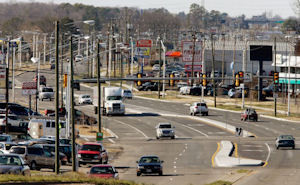
The Midlothian Turnpike in Chesterfield County: a classic stroad. Photo courtesy of the Richmond Times-Dispatch.
by James A. Bacon
Americans, asserts Charles Marohn in his book “Thoughts on Building Strong Towns,” do not understand the difference between streets and roads. That conceptual confusion has resulted in untold billions of dollars in bad investment as traffic engineers have melded the two in what Marohn and others have contemptuously term “stroads.”
I bring this up because I cannot imagine that any state suffers more from the affliction of stroads than Virginia does. Worse, I don’t see that anyone writing editorials, commentary or white papers in the Old Dominion who understands what we have done to ourselves. All I see is the relentless call to increase taxes so we can spend more money to “fix” the problem that we created through carelessness and ignorance.
As Marohn explains:
Roads move people between places while streets provide a framework for capturing value within a place.
The value of a road is in the speed and efficiency that it provides for movement between places. Anything … that reduces the speed and efficiency of a road devalues that road. If we want to maximize the value of a road, we eliminate anything that reduces the speed and efficiency of travel.
The value of a street comes from its ability to support land use patterns that create a financial return. The street with the highest value is the one that creates the greatest amount of tax revenue with the least amount of public expense over multiple life cycles. If we want to maximize the value of a street, we design it in such a way that it supports an adjacent development pattern that is financially resilient, architecturally timeless and socially enduring.
Rather than maximizing the efficiency of streets and roads, we have combined their functions to the detriment of both. Stroads, designed to move traffic at 45 or so miles per hour, create the worst of both worlds. Rather than accommodating complete streets that allow for automobiles, transit, bikers and pedestrians, stroads focus on moving automobiles exclusively. In exchange for bumping up local speed limits 10 or 20 mph that save motorists a few fractions of a minute in driving time, stroads effectively banish other modes of transportation from the scene. In so doing, as I noted in a previous post (“Wealth-Destroying Streets“), they destroy property values and dampen tax revenues.
At the same time, we have ruined state highways across the Old Dominion by allowing them to evolve into commercial streets cluttered with driveways, cut-throughs and stop lights. Thus, to pick an example frequently mentioned on this blog, government officials in Charlottesville and Albemarle County enacted policies over the past three or four decades that gradually converted U.S. 29 north of Charlottesville from a state highway into a local street that now requires a $244 million bypass to circumvent. Of course, local government officials have done the same thing in Danville, Lynchburg, Warrenton, Gainesville and even in rural counties in between. State officials have awakened to the need for “access management” but they have done so way too late in the game — the damage is irreparable. Virginia does not have the money to fix its ruined highways.
One of the dangers of the Governor Bob McDonnell’s tax increase is that it will absolve transportation policy makers of the need to return to first principles. Rather than re-think how we invest our transportation dollars, we will continue to degrade more highways into stroads and build more stroads that degrade property values. We will continue merrily upon our wealth-destroying ways until the money runs out.


